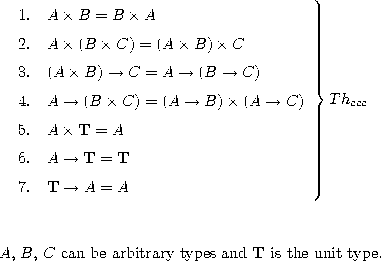Next: Digression: Tarski's High School Up: Isomorphisms of Types: from Previous: Isomorphisms of Types: from
An historical survey of results
There has been a very interesting work dedicated to the characterization of the
isomorphisms holding in some special classes of categories [Sol83],
even since 1981.![]() In his
work, Soloviev focuses on a special class of categories, called
cartesian closed categories, where for any two objects AA and
BB there exists a product
In his
work, Soloviev focuses on a special class of categories, called
cartesian closed categories, where for any two objects AA and
BB there exists a product  , an exponent
, an exponent
 , and a special object T called the
terminal object, with a set of additional properties
that make them very well suited as models of the typed
, and a special object T called the
terminal object, with a set of additional properties
that make them very well suited as models of the typed  -calculus (see for example [Sza78, LS86] and Chapter 8
of [AL91]).
-calculus (see for example [Sza78, LS86] and Chapter 8
of [AL91]).
If categorical tools are increasingly used to give semantics to programming
languages, especially to functional ones, this is also due to a close connection
between this class of categories and the typed  -calculus. It is by now
a very well known fact that the models of
-calculus. It is by now
a very well known fact that the models of  -calculus with
products and unit type are exactly the cartesian closed categories (shortly,
ccc's), or, equivalently, that this calculus is the internal
language of ccc's (see [Min77, LS86, AL91]).
-calculus with
products and unit type are exactly the cartesian closed categories (shortly,
ccc's), or, equivalently, that this calculus is the internal
language of ccc's (see [Min77, LS86, AL91]).
Due to this connection, this categorical problem coincides with the characterization of isomorphisms in typed lambda calculus, which is particularly interesting for the case of ccc's. It is a simple exercise in basic category theory to show that in any ccc, the following isomorphisms hold:

Table 1: The theories of valid isomorphisms for ccc's.
In 1981, Soloviev showed, using techniques developed in number theory several years before, that these are exactly the isomorphisms holding in all ccc's. It is worthwhile to present here in some more details the connection with number theory used by Soloviev, as it is another interesting case of connection between very different branches of Mathematics.
If we take the table of isomorphisms of types above and we read it by taking
T as the number 1, type variables as numerical variables, AABB  as the regular product AB of two numerical expressions A and B, and
finally AABB
as the regular product AB of two numerical expressions A and B, and
finally AABB  as the exponent
as the exponent  , then the isomorphisms
above become very well-known numerical identities that are taught in high-school
algebra classes. The reason for this is that natural numbers can be used to
build a cartesian closed category: to each n we associate a finite set with
n elements, and as morphisms between two objects m and n we
take the
, then the isomorphisms
above become very well-known numerical identities that are taught in high-school
algebra classes. The reason for this is that natural numbers can be used to
build a cartesian closed category: to each n we associate a finite set with
n elements, and as morphisms between two objects m and n we
take the  usual set theoretic functions between the associated finite
sets.
usual set theoretic functions between the associated finite
sets.![]() In this category, the terminal object is the
singleton associated with 1, while the product and exponent
correspond directly to numerical product and exponentiation. Using these facts,
it is easy to show that two objects are isomorphic in the
category of finite sets if and only if they are equal as numerical
expressions. This means that we have reduced the problem of characterizing
isomorphic types in the category of finite sets to the problem of
finding all valid numerical equation between expressions built
out of product, exponentiation and the constant 1
only. This number theoretic problem is a particular case of what is known under
the name of Tarski's High School Algebra
Problem, and has as a solution exactly the set of equations
of the Table 1 above. This remarkable fact allows us to conclude
Soloviev's argument as follows: on one side, we have a set of isomorphisms that
is valid in all ccc's; on the other hand, we have found a special
ccc where only these isomorphisms hold. Hence, there cannot be any
other isomorphism holding in all ccc's, and we are done.
In this category, the terminal object is the
singleton associated with 1, while the product and exponent
correspond directly to numerical product and exponentiation. Using these facts,
it is easy to show that two objects are isomorphic in the
category of finite sets if and only if they are equal as numerical
expressions. This means that we have reduced the problem of characterizing
isomorphic types in the category of finite sets to the problem of
finding all valid numerical equation between expressions built
out of product, exponentiation and the constant 1
only. This number theoretic problem is a particular case of what is known under
the name of Tarski's High School Algebra
Problem, and has as a solution exactly the set of equations
of the Table 1 above. This remarkable fact allows us to conclude
Soloviev's argument as follows: on one side, we have a set of isomorphisms that
is valid in all ccc's; on the other hand, we have found a special
ccc where only these isomorphisms hold. Hence, there cannot be any
other isomorphism holding in all ccc's, and we are done.
Next: Digression: Tarski's High School Up: Isomorphisms of Types: from Previous: Isomorphisms of Types: from Roberto Di Cosmo
Mon Aug 30 11:21:44 MET DST 1999
